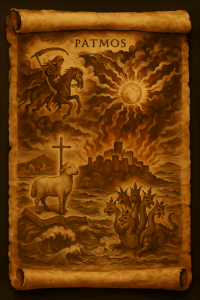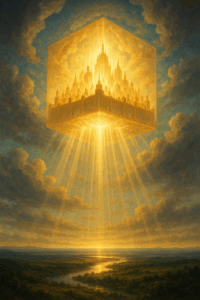Revelation Through Covenant Eyes-10-Snapshots

10 Snapshots That Will Transform Your Reading of the Apocalypse
Introduction: A Fresh Vision
Most readers approach Revelation with either fascination or fear. This apocalyptic finale to Scripture has inspired everything from end-times speculation to cultural panic. But what if we’ve been reading it through the wrong lens?
These 10 snapshots introduce a revolutionary approach to Revelation through three Hebrew concepts that illuminate God’s character throughout Scripture:
- Ḥesed (חֶסֶד) – God’s steadfast, unfailing love
- Qadosh (קָדוֹשׁ) – God’s perfect holiness
- Berith (בְּרִית) – God’s faithful commitment to covenant
This lens transforms Revelation from a frightening prediction of catastrophe into a powerful revelation of God’s covenant faithfulness even in the darkest times.
Snapshot 1: The Exiled Witness
“I, John, your brother and companion in the suffering and kingdom and patient endurance that are ours in Jesus…” (Revelation 1:9)
John writes not from a position of power but from exile on Patmos. This matters profoundly. Revelation is not the speculation of a comfortable theorist but the testimony of one who suffers for his faith.
The book speaks directly to believers facing the pressure of an empire that demands ultimate allegiance. When John’s first readers heard his visions, they didn’t check their prophetic timelines—they found courage to maintain their witness under pressure.
Snapshot 2: The Lamb at the Center of Revelation
“Then I saw a Lamb, looking as if it had been slain, standing at the center of the throne…” (Revelation 5:6)
The controlling image of Revelation is not the beast, the dragon, or even the throne—it is the slain yet standing Lamb. This paradoxical figure reveals that God conquers not through violence but through self-giving love.
When the elders ask who is worthy to open the scroll, John hears about a Lion but turns to see a Lamb. This profound moment teaches us that God’s power operates differently than empire’s power. The Lamb’s victory through sacrifice defines everything that follows.
Snapshot 3: Seven Letters, One Message
In Revelation 2-3, Christ addresses seven churches in Asia Minor. Through covenant eyes, these letters reveal not merely warnings but Christ’s deep engagement with His people:
- To Ephesus: “You have forsaken the love you had at first” (2:4)
- To Smyrna: “Be faithful, even to the point of death” (2:10)
- To Laodicea: “Those whom I love I rebuke and discipline” (3:19)
These are not form letters but covenant conversations. Each church receives a unique message tailored to their circumstances, demonstrating Christ’s intimate knowledge of His covenant people.
Snapshot 4: The Horsemen Reframed
The four horsemen of Revelation 6 are typically viewed as agents of destruction. Through covenant eyes, we see a different pattern:
- White Horse: Divine truth riding forth, offering one more opportunity for recognition
- Red Horse: Peace is not taken truth of its absence is revealed
- Black Horse: Economic injustice following abandonment of covenant righteousness
- Pale Horse: Death that follows when life is pursued apart from its Author
This sequence reveals God’s covenant pattern: truth always precedes consequence. God sends the white horse first—offering revelation before judgment unfolds.
Snapshot 5: Sealed with Promise
“Do not harm the land or the sea or the trees until we put a seal on the foreheads of the servants of our God.” (Revelation 7:3)
Before judgment comes, God’s people are sealed. This is not arbitrary selection but covenant identification. The sealed are not spared from suffering but sustained through it.
Later, we see those with “the Father’s name written on their foreheads” (14:1), contrasting with those bearing the mark of the beast. The fundamental question of Revelation becomes: Which mark identifies you? Whose name defines your thinking and action?
Snapshot 6: The Surprising Fall of Babylon
“Fallen! Fallen is Babylon the Great, which made all the nations drink the maddening wine of her adulteries.” (Revelation 14:8)
Babylon—the great city representing human empire and idolatry—falls not primarily through divine violence but through its own internal contradictions. The kings and merchants who supported her turn against her (17:16).
This reveals a profound covenant truth: Systems built on domination, exploitation, and idolatry contain the seeds of their own destruction. God’s judgment often involves letting human kingdoms collapse under the weight of their own contradictions.
Snapshot 7: The Blood-Dipped Robe
“He is dressed in a robe dipped in blood, and his name is the Word of God.” (Revelation 19:13)
The Rider on the white horse in Revelation 19 appears with a robe already dipped in blood before the battle begins. This is not his enemies’ blood but his own—the blood of covenant sacrifice.
His primary identity is not warrior but witness—“the Word of God” and “Faithful and True.” He conquers not through physical violence but through faithful testimony and self-giving love. This transforms our understanding of divine victory.
Snapshot 8: A Judgment of Truth
The great white throne judgment (Revelation 20:11-15) is often read as terrifying condemnation. Through covenant eyes, it reveals:
- Books recording not just actions but covenant responses
- Judgment that confirms rather than determines destiny
- Truth that exposes reality rather than arbitrary sentencing
This judgment scene represents not divine vengeance but covenant completion—the necessary fulfillment of promises to establish justice and remove all that opposes covenant life.
Snapshot 9: The Descent of the City
“I saw the Holy City, the new Jerusalem, coming down out of heaven from God…” (Revelation 21:2)

In the climactic vision of Revelation, we don’t ascend to heaven—heaven descends to earth. The New Jerusalem comes down, representing God’s covenant presence dwelling with humanity.
This is not escape from earth but the healing of earth. Not the abandonment of creation but its transformation. Not the end of God’s covenant story but its glorious fulfillment in a renewed creation where “God’s dwelling place is now among the people” (21:3).
Snapshot 10: The Final Invitation
“The Spirit and the bride say, ‘Come!’ And let the one who hears say, ‘Come!’” (Revelation 22:17)
Revelation ends not with destruction but with invitation. The final word is not judgment but welcome—not threat but promise.
This open invitation reveals the heart of God’s covenant purpose: not to condemn the world but to restore relationship. The God revealed in Revelation is not eager to judge but eager to welcome all who thirst for the water of life.
Your Invitation to See More
- How each symbol connects to God’s covenant history with Israel
- Why the structure of Revelation matters for its interpretation
- How specific passages transform when read through ḥesed, qadosh, and berith
- What this means for faithful witness in our own time
Our full commentary “Revelation Through Covenant Eyes” explores these depths and more, offering a comprehensive reading that will transform your understanding of this powerful book.

🕊️ Theology of the Lamb — a theological deep dive